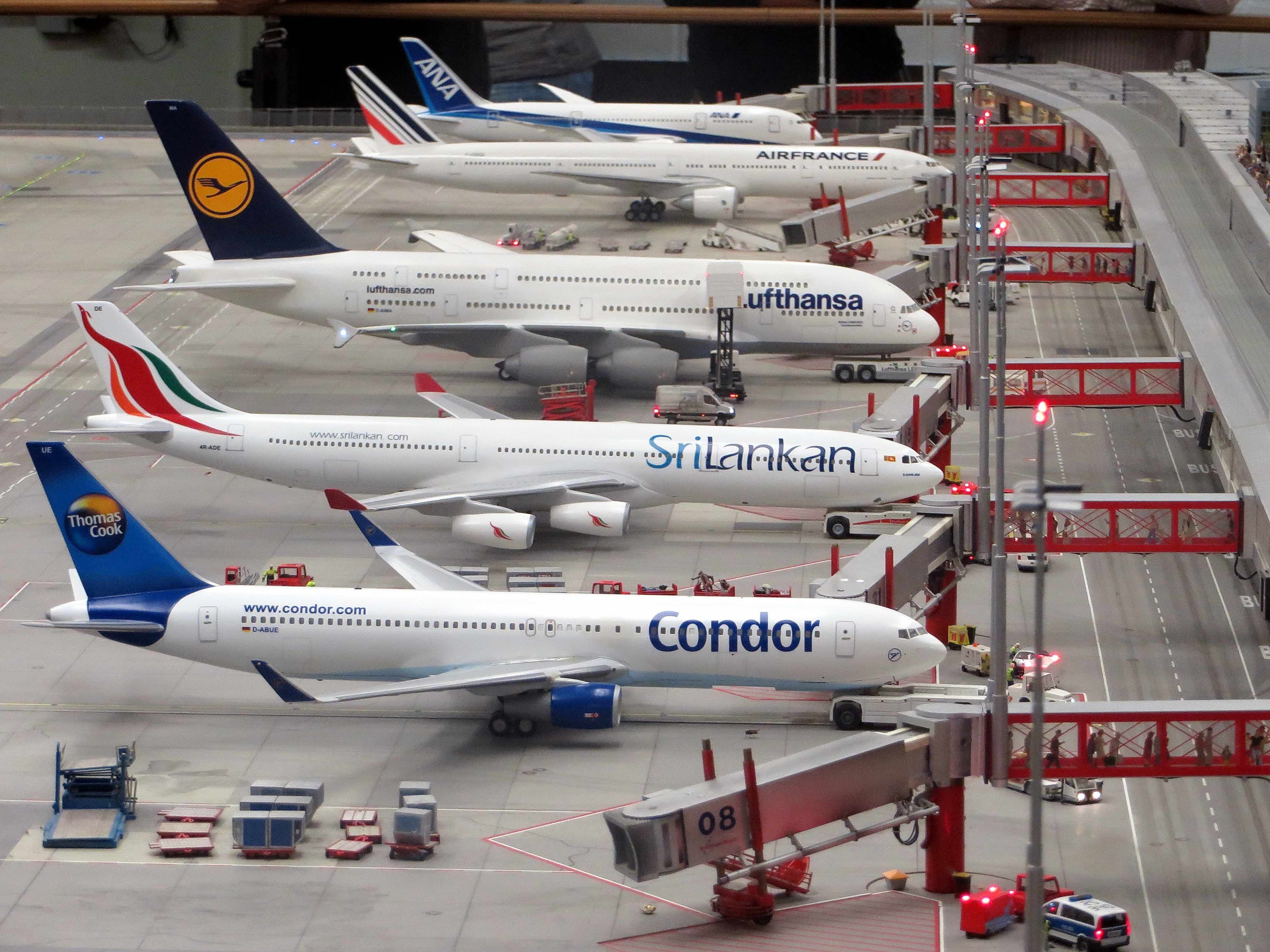Beyond Paris: Other International Efforts to Address Climate Change
The modern economy is built on an international transportation infrastructure that is largely invisible to the consumer. Nearly every banality of modern life, from the clothes people wear to the out-of-season food they eat, is possible only because goods can move easily by air and sea across vast distances, at a low cost.

Published by The Lawfare Institute
in Cooperation With

The modern economy is built on an international transportation infrastructure that is largely invisible to the consumer. Nearly every banality of modern life, from the clothes people wear to the out-of-season food they eat, is possible only because goods can move easily by air and sea across vast distances, at a low cost.
Though beneficial for the consumer, this convenience has had adverse consequences for the planet. As international shipping and aviation have become increasingly central to the global economy over the past few decades, greenhouse gas emissions from these sectors have risen dramatically—despite improvements in the energy efficiency of both shipping and aviation. If these sectors were countries, they would be the world’s sixth- and eighth-largest emitters, responsible for more annual emissions than Germany and Canada, respectively. By 2050, emissions from shipping could grow between 50 and 250 percent, while emissions from aviation could grow between 40 and 340 percent. The international community cannot achieve the Paris Agreement’s goal of limiting warming to 2 degrees Celsius if it does not significantly curtail emissions from these sectors.
Despite the magnitude of their contribution to anthropogenic warming, however, greenhouse gas emissions from international shipping and aviation have been largely unregulated. Indeed, these sectors are explicitly excepted from the current climate regime under the auspices of the United Nations Framework Convention on Climate Change (UNFCCC). The 1997 Kyoto Protocol assigned absolute emissions reduction targets to developed country parties. But these parties could not agree among themselves how to assign the emissions generated from international aviation and shipping. Instead, Article 2.2 of the Kyoto Protocol directs developed countries to pursue limitation or reduction of emissions of greenhouse gases from aviation and shipping in the two U.N. agencies with technical expertise over these sectors, the International Civil Aviation Organization (ICAO) and the International Maritime Organization (IMO).
The fact that the Kyoto Protocol, and by implication the Paris Agreement that replaces it, carved these two industries out of its purview allows for a comparative analysis of the UNFCCC regime (which includes the Paris Agreement), on the one hand, and the industrial-sector approach, on the other. Comparison of these two different international approaches to climate change offers an opportunity to assess which of these two mechanisms is more effective in achieving the kinds of deep cuts in greenhouse gas emissions necessary to stave off climate disaster. Examining the climate efforts within ICAO and IMO, this post assesses whether this alternative international approach offers structural advantages that allow it to be more effective than the UNFCCC in reducing emissions.
ICAO
The International Civil Aviation Organization is a U.N. agency governed by the 1944 Chicago Convention on International Civil Aviation. ICAO develops international aviation standards (called standards and recommended practices, or SARPs) to help states achieve uniformity in civil aviation regulations, standards, procedures and organizations. After the Kyoto Protocol punted the greenhouse gas emissions reduction question to ICAO in 1997, the organization mostly dithered. That changed in 2008, when the European Union announced that, beginning in 2012, it would include international aviation under its EU-wide cap-and-trade scheme. This would have required all flights traveling to or from the EU to purchase greenhouse gas allowances from the European market, even for emissions that did not occur over EU airspace.
The unilateral move to regulate international aviation provoked indignant responses in both Washington and Beijing. In 2012, Congress passed legislation to prohibit U.S. carriers from participating, while China threatened to cancel orders for European Airbus aircraft. Several carriers also challenged the regulation in the European Court of Justice on the grounds that inclusion of flights originating outside the EU violated international law, though the court disagreed. The Europeans eventually agreed to suspend the application of their cap-and-trade program to international aviation, but only if progress was made on an international scheme for regulating emissions from aviation. Technically, the EU regulation is still in place, but the formal suspension has been renewed several times.
Largely in response to European pressure, ICAO has adopted a basket of measures to address greenhouse gas emissions from international aviation. The first is the Carbon Offsetting and Reduction Scheme for International Aviation (CORSIA), formally adopted in 2016. CORSIA is a program designed to achieve “carbon neutral growth.” The program requires participating nations’ airline operators to offset any emissions growth beyond a 2020 baseline by purchasing verified emissions “offsets” on the open market. The program will operate in three phases. The first of these, an opt-in pilot phase, runs from 2021 to 2023; although this phase is entirely voluntary, states that cumulatively generate approximately 86 percent of international aviation emissions have agreed to participate. The second phase, which is also voluntary, runs from 2024 to 2025. The third phase, from 2027 to 2035, covers all states, save countries with extremely low global aviation market share, least developed countries, small island developing states and landlocked developing countries, unless countries in these latter groups participate voluntarily.
Aside from CORSIA, ICAO is also addressing greenhouse gas emissions through its mandatory carbon dioxide standards for new aircraft. These standards, the first to impose binding efficiency targets on the aviation sector, were formally adopted in 2017 and will be enforced beginning in 2028. ICAO has also adopted a handful of other, less consequential measures.
Both CORSIA and the efficiency standards have been criticized on a number of grounds. Critics of CORSIA note that the program covers only emissions growth (not absolute emissions), and only from a subset of countries. Even if it works as designed, CORSIA will cover only approximately 25 percent of international aviation emissions—and will do nothing to reduce emissions below the 2020 baseline. There are also concerns about the integrity of the emissions reduction credits and the program’s overall lack of transparency. Meanwhile, the carbon dioxide efficiency standards have been criticized for being too lax. According to one group, new commercial aircraft already comply with the standards. In this sense, the ICAO efficiency standards are not driving additional emissions reductions, but will only prevent backsliding.
The ICAO SARPs are not self-implementing but must be adopted by member states. Member states may ban the use within their airspace of any aircraft that do not meet ICAO standards. Within the U.S., it is not clear where things stand on implementation of either CORSIA or the efficiency standards. The U.S. Federal Aviation Administration (FAA) is responsible for implementing the regulatory framework necessary to adopt CORSIA, which is supposed to be done by 2020. The FAA has claimed that this timeline is impossible but is expected to release policy guidance soon and adopt regulatory language to implement CORSIA in the near future. Things are murkier with regard to the efficiency standards, which must be adopted by the Environmental Protection Agency (EPA) but are enforced by the FAA. The EPA took the preliminary step necessary to regulate emissions from aircraft in 2016, but it has yet to promulgate a regulation and has been silent about when it might do so. The EPA has an obligation under international law and domestic law to promulgate a standard and would be vulnerable to a legal challenge if it does not do so.
IMO
The International Maritime Organization is an international agency governed by the Convention on the International Maritime Organization and, like ICAO, is a standard-setting authority. IMO exists to set universal standards governing the safety and security of shipping, as well as to prevent marine and atmospheric pollution by ships. Unlike ICAO, which has not historically taken on an environmental sustainability role and whose convention does not mention the environment, IMO has been addressing shipping-related pollution since the late 1960s. Until recently, the organization’s air quality work focused on regulating traditional air pollution (sulfur oxides, nitrogen oxides, particulate matter and volatile organic compounds), with the most recent revision, effective in 2020, lowering the amount of allowable sulfur in ship fuel. The Trump administration recently failed in its attempt to effectively delay the onset of these sulfur rules.
Despite IMO’s long-standing experience regulating environmental issues and air pollution in particular, the agency’s progress on greenhouse gas emissions has been slow. IMO first invited members to begin work on carbon dioxide reduction strategies in 1997, but it wasn’t until 2011 that the organization took any concrete steps to reduce emissions. That year, IMO promulgated mandatory energy efficiency standards for new ships (EEDI/SEEMP), the first regulation establishing carbon dioxide standards for ships. The standards get more stringent over time; by 2030, they require new ships to be 30 percent more efficient than the baseline of ships built between 1999 and 2009 (the U.S. Coast Guard implements EEDI/SEEMP in the U.S.). Beginning in 2018, the agency began to require ships of greater than 5,000 gross tonnage to collect consumption data on each type of fuel oil used, which are then reported to the nation under whose flag each sails. IMO ultimately makes these data available annually.
In April 2018, however, IMO took its most ambitious step yet, establishing an initial strategy for addressing climate change and adopting a quantitative goal of reducing greenhouse gas emissions at least 50 percent by 2050 compared with 2008 emissions, among other targets. This outcome was not foreordained: Some countries pushed for more aggressive targets, while the Trump administration was opposed to setting a quantified target.
The goal of reducing emissions by at least 50 percent may sound like meaningful progress, but in reality IMO did not decide how to achieve the goal it set for itself. As IMO admits, the initial strategy is only a framework for further action. The organization initially gave itself five years to decide what policies to adopt to meet these broader goals, with a final strategy to be set in 2023. In the interim, there will be an intense focus on the policies and measures—such as reducing ship speeds, increasing energy efficiency and developing alternative fuels, among others—that IMO will adopt to meet these targets. These measures will likely be legally binding, which means the real fight over emissions reductions is still brewing. The process to select measures has barely begun but is already proving difficult.
So What?
As the IMO and ICAO efforts demonstrate, there are many ways to think about multilateral climate action. The UNFCCC’s territorial approach, where each nation is assigned responsibility for all emissions within its territory regardless of the source of those emissions, is only one such possibility. Using international standard-setting organizations to address emissions on an industry-by-industry basis, regardless of where the emissions originate, is another.
How do these approaches compare? It is easy—and fair—to criticize the steps taken by ICAO and IMO as insufficiently ambitious. In the case of ICAO, the commitments are so anodyne that they are essentially the same as those voluntarily adopted by the airline industry in 2009. Not only are they not ambitious enough to achieve their share of the effort to keep warming within 2 degrees Celsius, but the ICAO and IMO measures may not result in emissions reductions at all. Indeed, CORSIA is designed not to reduce aviation emissions, but to allow for carbon-neutral growth. Further, ICAO has no formal plan to address international aviation emissions beyond 2035, when CORSIA formally ends. In addition, it remains unclear how aviation will decarbonize in the long-term, as even the most frequently mentioned solution—the development of alternative fuels—is not currently technologically feasible, much less commercially available. But at least ICAO has sketched out the details of its program for curtailing emissions growth, which is more than can be said for IMO. The latter organization has set a reasonably ambitious goal but has given itself until 2023 to agree on what to do to achieve it—at which point, it will probably be several more years before any adopted measures will be implemented. In short, both ICAO and IMO have taken decades to achieve minimal progress and their existing proposals are embarrassingly modest. What is more, the success of both CORSIA and the IMO strategy remain to be seen.
Yet there is also reason to think that, in the long term, keeping international shipping and aviation outside of the UNFCCC may provide a more effective model for solving some of the intractable institutional problems that beset the current international climate regime. In theory, both ICAO and IMO are putting frameworks into place that may, down the line, be more successful than if their emissions were regulated entirely by the domestic political process within states.
First, the principle of common but differentiated responsibilities is, by definition, inapplicable in the ICAO and IMO context. This principle, enshrined in the UNFCCC (and, by extension, the Paris Agreement), holds that, while states have a common responsibility for addressing climate change, not all countries contributed equally to emissions or are equally able to address climate change—and as a result, country responsibilities for reducing greenhouse gas emissions are differentiated based on their level of development and their level of historical emissions. This means that countries like China are less obligated to address emissions than historically important, developed country emitters like the United States. This principle bogged down the UNFCCC process by dooming the Kyoto Protocol. Differentiation continues to be a point of enormous sensitivity among the parties to the Paris Agreement, sparking contention at the most recent international climate meeting about whether and how differentiation should apply to the Paris Agreement’s transparency framework.
ICAO and IMO, by contrast, enshrine principles of nondiscrimination—equal treatment for all states—in their enabling treaties. Although some critics may argue that not acknowledging differing circumstances is a deficiency in the international climate context, these organizations are ultimately able to come to consensus because, for the most part, every party has the same obligations. These organizations have also been able to accommodate differing responsibilities and capabilities through innovative program design (for example, by allowing voluntary participation for least developed countries in CORSIA).
Second, both IMO and ICAO are, by definition, standard-setting regulatory bodies that have the authority to impose legally-binding standards on their members, including emissions reduction policies. This is a stark contrast with the Paris Agreement, under which emissions reduction commitments are pointedly nonbinding and there is no enforcement mechanism. It takes a lot of political will for IMO and ICAO to exercise their standard-setting authority, but when these organizations do act, there are real enforcement mechanisms (for example, ICAO member states may ban the operation of airline operators from states that have not adopted their standards). Finally, both IMO and ICAO are technical bodies that have many interests beyond climate change. Their diverse portfolio of issues—including must-agree issues such as safety—is beneficial in several ways: It allows for trust to be built up among the parties, it allows for negotiation across a broader swath of issues, and it is lower profile and more technical than the UNFCCC meetings.
To be clear, these structural differences are not themselves sufficient to achieve aggressive climate action. IMO and ICAO still require consensus among reluctant states and have heavy involvement from industry, whose interests are not necessarily aligned with stringent climate action, and the technical nature of the meetings can inhibit transparency and ambition. But they arguably provide a more solid institutional foundation for concerted international action on climate than can be found within the UNFCCC and the Paris Agreement.
For the past 30 years, international climate mitigation efforts have focused almost exclusively on the UNFCCC process. Yet it is far from evident that a long-term climate solution will come from within the UNFCCC, which has also been unable to catalyze countries’ political will to take the kinds of economically painful actions needed to address climate change. The solution is not simply to focus more intently on the UNFCCC, hoping that the structural and economic barriers that have long plagued the talks will be overcome through further negotiations. The point is not that ICAO and IMO offer the alternative model; rather, it is not clear that it is optimal to place nearly all international climate negotiations in one institution, or in one institutional model.
Recent actions at IMO and ICAO are not necessarily a replicable model for all industries, and, more importantly, they do not offer a solution to the broader problem that governments lack the political will to meaningfully address climate. But they do suggest that it is time for a broader re-imagining of the form and structure of international climate institutions. The inescapable reality is that climate action is currently beset by the overarching problem of political will, regardless of institutional form. But that doesn’t mean all institutional approaches are equal. Standard-setting organizations have limitations, but they also offer structural advantages that hold out the possibility of more permanent change than has been possible over the past 30 years of UNFCCC whiplash.





